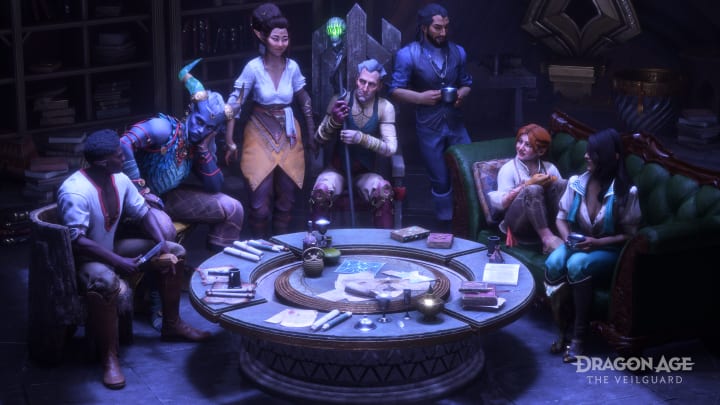Dragon Age: The Veilguard review — hollow and clinical with small flashes of brilliance

So much of Dragon Age: The Veilguard happens in the character creation screen. Your character’s history – whether they were a necromancer, an assassin, or a Grey Warden – combines with your race, gender, and starting class to create a profile that other characters in the world react to. It’s impressively fluid. As a Watcher of the Necropolis, I felt at home in that faction’s haunted halls. A colleague played as a nonbinary Qunari and uncovered exclusive dialogue options when talking to a nonbinary companion, which could be life-affirming to someone struggling with acceptance – it goes surprisingly deep and makes conversations feel personal.
People remember what you’ve said and react accordingly, with entire conversations taking significant turns depending on how you approach them. There’s more flavor than Flavor Flav — and he has one and a half flavors!
But it is just that: flavor.
No matter what you do, the male main character is always a cross between Captain Jack Sparrow and William Butcher. Still, creating their history allows for proper roleplay within that framework. It’s just a shame this rarely extends beyond your choices before the game even starts. Lots of dialogue changes based on who you created, and there are small diversions due to what you say, but you rarely impact the world because of your actions while playing. Your history takes the driver’s seat.
It’s difficult to detach Veilguard from its history, too. It’s not the Dragon Age I remember, where random sidequests challenged you with moral dilemmas, demons tempted you with power, characters were covered in blood in every cutscene (yes, blood spatter is gone), and the world was filled with horrors. Veilguard fully commits to the jump from dark heroic fantasy to straight-up heroic fantasy. If Dragon Age: Origins was the 1998 movie Blade, this is Guardians of the Galaxy.
A lot of the dialogue in Veilguard has that same, sarcastic, quippy tone of the Marvel movies. It’s like someone crunching an ice pop in your ear. There are rare moments where excellent writing reaches through the screen and makes you consider your mortality, but it’s inconsistent. Compelling conversations about religion, history, and the interpretations of both are juxtaposed against voice lines where people say things like “watch out, these guys GO HARD”, “were they… doing it?”, or “taking the p*ss”. It pulls you right out of the fantasy setting. These characters definitely know what TikTok is.
If you created a flowchart of my enjoyment while playing Veilguard it’d look like a heartbeat monitor after a 200m sprint. The good moments are up there with BioWare’s best-ever work – the spectacle in some of the main missions is beyond even Mass Effect 3’s apocalypse – but the low points are many and scattered across the entire experience.
At one point, I walked in on two of my companions – a grey warden with a pet griffon and an assassin haunted by a spite demon – exchanging war stories. One fought a ball of nugs (Dragon Age’s fleshy rabbits) bound together into a mass of limbs and teeth by blood magic. The other tells a story about fighting a katamari of tentacles the size of a building. I spent the whole conversation wondering why I’ve spent the entire game fighting generic goons.
The demons highlight many of the game’s problems. Like with our haunted assassin (who BioWare also does nothing interesting with), there are many ways to weave demons into the story and sidequests, but here they’re just mindless monsters with large health bars that you whittle down in dull combat encounters. If you love tinkering with skill trees, there’s a lot to like about how you can build out your character into something game busting – intentionally so – but you soon realize that you’re doing it so you can skip past encounters as quickly as possible. By two-thirds of the way in, I turned the game down to Easy difficulty to make them go by even faster.
You can dodge, parry, attack close up, attack from range, and break guards, but there’s so much going on visually that it’s hard to tell what to do at any given time. Readability sucks. It doesn’t make combat difficult – it just makes it a slog. Even the healing system is dumbed down, limiting you to three potions (you can get more from equipment, skills and, you guessed it, the character creation process) which you can top up by smashing jars conveniently spaced around each combat arena like you’re playing a PS3 cover shooter.
Outside combat, a series of awful puzzles repeat and pad out the runtime. In some, you carry ghosts to receptacles. In others, you smash red crystals in a specific order. Then there are the crystal puzzles again, but you’re smashing pulsating blight growths instead. These appear frequently in exploration and quests, murdering the pacing. In one mission, my party was rushing against time to save some innocents. I killed waves and waves of blood mages before being forced to stop for a five-minute detour where I had to search for these magic crystals to lower a barrier, sapping every bit of tension from the scene.
- Related: The best RPGs to play right now
It’s an incredibly polished video game with barely any bugs, but wait... Here are some things that bugged me.
There’s no suggested level on sidequests, so the only way to find out if you’re under-leveled is to go there and get stomped in a futile fight or chip away in a fight that takes too damn long. To make things more confusing, only some enemies have their level next to their health bars, while others do not.
You have to go to the map to open the quest log, for some reason.
Some chests randomly poison you. When suffering a status effect, the game thinks you’re in combat and won't let you equip whatever you just got from the chest.
Jump and interact on the same button again and I think whoever decided this should go to jail.
Every city you visit is a series of linear corridors with sad NPCs idling on street corners. You can barely interact with anyone in these hub areas, but there are shops, each marked by an armor icon. Except only some of them sell armor. You’ll also find vendors stocking things like onions and fish. You can buy these onions and fish. What can you do with the onions and fish? Sell them. That’s it. That’s all you can do.
There are dozens and dozens of junk items with no use but to sell, yet they’re stocked in shops for some reason. It almost feels like BioWare remembered it was making an RPG a little too late and plopped the extra shops down to make the cities feel slightly less dead and artificial. There’s an inescapable sense that Veilguard is like the sentient skeleton companion who joins you with necromancer party member Emmerich – made from the bones of all the dead Dragon Age games murdered during its troubled development cycle.
It’s apparent in the beggars dotted around each city. Pass them by and you can interact with their collection bowls, triggering an animation where you crouch down and give them a coin. Except you don’t. Not really. You don’t lose any gold. It’s just an animation. The beggars don’t even react. It’s a facade, a late attempt to cover up a hollow illusion. The same goes for dog petting — the animals don’t even react when you crouch down to pet them, but at least BioWare will get free publicity from that one Twitter account.
It’s a shame because it’s gorgeous. Drop dead gorgeous. It’s easily the best-looking game BioWare has ever made. From Venetian cities to windswept beaches, there’s so much variety and all of it is stunning. It just doesn’t do anything interesting with these beautiful locations. Actual depth has been sacrificed for surface-level visuals and a large, strangely disconnected world.
Origins had you choosing locations from a map just like this, but you progressed up it as you marched. Here you walk through magic mirrors connecting to the wider world like a magic spider’s web so there’s no sense of cohesion. It’s also lacking transitions (remember how you’d leave a planet on your ship in Mass Effect?). At one point, I was talking about rescuing someone from an underwater prison. The next minute, I’m in the prison, underwater, with no explanation of how I even got there. It makes the whole thing feel disjointed and cheap, and the Varric-narrated comic strip chapter bookends don’t make up for it.
This is only heightened by how clinical it all feels. It’s a typical BioWare structure and borrows the best bits from the studio’s previous games. It’s so note for note that you’ll know when it’s time to consummate a relationship you’ve been cultivating. You’ve done all of this before, even if not quite at this fidelity. How convenient is it that every companion you recruit has a personal tie to each of the friendly factions you encounter?
There’s a lot of Mass Effect in The Veilguard. BioWare took some of the best parts of its best games and smashed them together, which isn’t a complaint — I love BioWare’s older titles. The final mission is like a mix between Mass Effect 2 and 3’s finales, and it’s one of the best payoffs I’ve seen in a game – a real spectacle. There are also plenty of endearing character moments (as long as you ignore Neve, who sounds like she’s reading a script at a eulogy), and the little gatherings you have with your team at your home base are peak BioWare. There are glimpses of brilliance, but there’s always something equally as bad dragging it down.
The story twist toward the end of the game ruins an otherwise excellent finale. I was in awe of what was playing out, watching every character I loved get their moment to shine in a series of cutscenes that rival the first time you see the Helm's Deep battle in Lord of the Rings. But then BioWare pulls one of the dumbest twists I’ve ever seen – a twist that makes no sense and robs players of an emotional payoff built up over multiple games. It’s genuinely depressing – not because it’s sad, but because it’s not sad and it should be. It detracts from an otherwise immaculate final few hours.
There are moments where The Veilguard is BioWare’s best game, but it’s blighted by everything else. I’d recommend skipping the throwaway side content and mainlining the brilliant main quests, but you’ll be punished in the final mission if you do. So you have no choice but to fast-travel from combat encounter to combat encounter, all while wondering where the moral dilemmas are in a series known for its player choice, where the interesting NPCs are in this RPG. Like the character I created at the start of this journey, I can’t separate The Veilguard from its history, and this isn’t the Dragon Age I remember – it’s the reanimated corpse of the studio’s former glory.
Score: 6/10
Version tested: PS5
